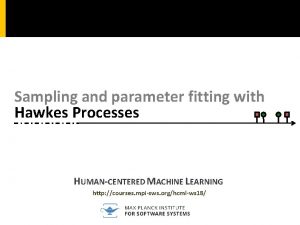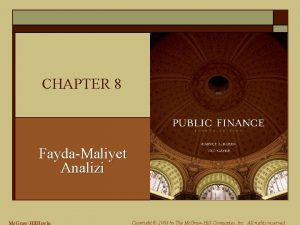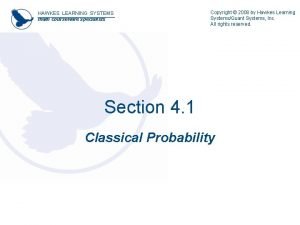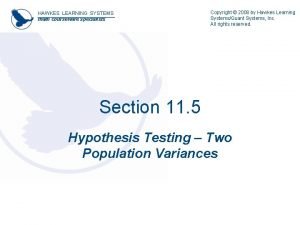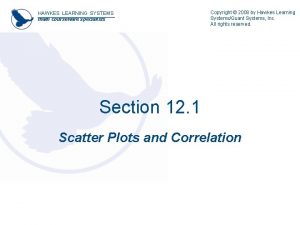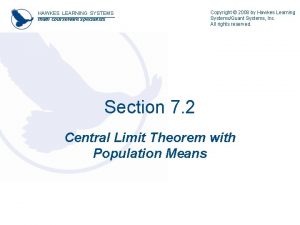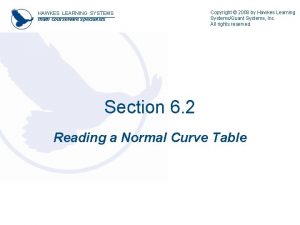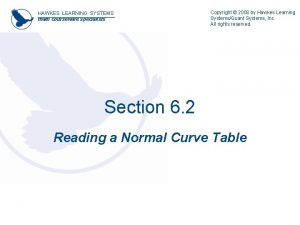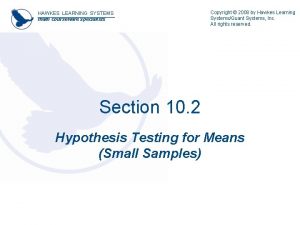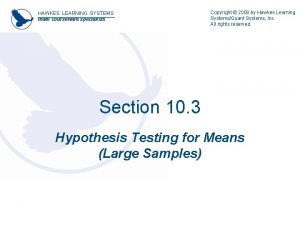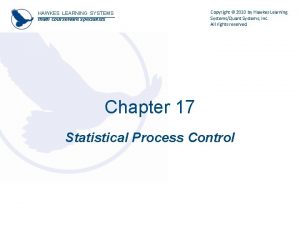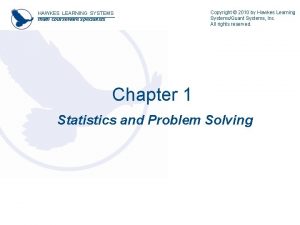HAWKES LEARNING SYSTEMS math courseware specialists Copyright 2008


















- Slides: 18

HAWKES LEARNING SYSTEMS math courseware specialists Copyright © 2008 by Hawkes Learning Systems/Quant Systems, Inc. All rights reserved. Section 2. 1 Frequency Distributions

HAWKES LEARNING SYSTEMS math courseware specialists Graphical Descriptions of Data 2. 1 Frequency Distributions Organizing Data: • Ordered array – an ordered list of the data from largest to smallest or vice versa. Ex. 1 2 2 2 4 5 5 6 • Distribution – displays data values that occur and how often they occur. It can be a chart or a table. 1 1, 2 3, 4 1, 5 2, 6 1 • Frequency Distribution – table that divides data into groups, called classes, and shows how many data values occur in each group. (1 -2 4) • Frequency, f – number of data values in a class. (4)

HAWKES LEARNING SYSTEMS math courseware specialists Graphical Descriptions of Data 2. 1 Frequency Distributions Creating frequency tables: 1. Decide on the number of classes • Between 5 and 20 2. Choose an appropriate class width • 3. Find the class limits • Start with the lowest value and add the class width to get the next class limit. (1 -2, 3 -4, etc) 4. Determine the frequency of each class • Count the number of data values in each class. (1 -2 4)

HAWKES LEARNING SYSTEMS math courseware specialists Graphical Descriptions of Data 2. 1 Frequency Distributions Other characteristics can be calculated once the basic frequency table has been constructed: 1. Classes boundaries • 2. Split the difference in the gap between the upper limit of one class and the lower limit of the next class. (1 -2 0. 5 – 2. 5) Midpoints = 2+1 = 1. 5 2 3. Relative Frequency = 4. 4 8 = 0. 5 (50%) Cumulative Frequency • The sum of the frequency for a given class and all previous classes.

HAWKES LEARNING SYSTEMS math courseware specialists Graphical Descriptions of Data 2. 1 Frequency Distributions Create a frequency distribution using 5 classes: Quiz Grades 9 3 5 4 7 8 10 8 6 7 4 5 2 7 8 10 7 9 10 1 8 6 10 9 8 Solution – First place the data in an ordered array: Quiz Grades – Ordered Array 1 2 3 4 4 5 5 6 6 7 7 8 8 8 9 9 9 10 10

HAWKES LEARNING SYSTEMS math courseware specialists Graphical Descriptions of Data 2. 1 Frequency Distributions Solution – continued: Since we have the smallest and largest values, we can find the class width. Round 1. 8 up to a sensible value, 2. Next begin building the class limits with the smallest data value in the set.

HAWKES LEARNING SYSTEMS math courseware specialists Graphical Descriptions of Data 2. 1 Frequency Distributions The frequency distribution: Quiz Grades Class f Class Boundaries Midpoint Relative Frequency Cumulative Frequency 1– 2 2 0. 5 – 2. 5 1. 5 2 3– 4 3 2. 5 – 4. 5 3. 5 5 5– 6 4 4. 5 – 6. 5 5. 5 9 7– 8 9 6. 5 – 8. 5 7. 5 18 9 – 10 7 8. 5 – 10. 5 9. 5 25 1 2 3 4 4 5 5 6 6 7 7 8 8 8 9 9 9 10 10

HAWKES LEARNING SYSTEMS math courseware specialists Graphical Descriptions of Data 2. 1 Frequency Distributions Create a frequency distribution using 6 classes: GPA’s 3. 2 2. 6 2. 9 2. 0 3. 1 3. 5 1. 8 1. 3 3. 8 3. 0 1. 1 2. 0 2. 5 3. 1 3. 4 Solution – First place the data in an ordered array: GPA’s – Ordered Array 1. 1 1. 3 1. 8 2. 0 2. 5 2. 6 2. 9 3. 0 3. 1 3. 2 3. 4 3. 5 3. 8

HAWKES LEARNING SYSTEMS math courseware specialists Graphical Descriptions of Data 2. 1 Frequency Distributions Solution – continued: Since we have the smallest and largest values, we can find the class width. Round 0. 45 up to a sensible value, 0. 5. Next begin building the class limits with the smallest data value in the set.

HAWKES LEARNING SYSTEMS math courseware specialists Graphical Descriptions of Data 2. 1 Frequency Distributions The frequency distribution: Quiz Grades Class f Class Boundaries Midpoint Relative Frequency Cumulative Frequency 1. 0 – 1. 4 2 0. 95 – 1. 45 1. 2 2 1. 5 – 1. 9 1 1. 45 – 1. 95 1. 7 3 2. 0 – 2. 4 2 1. 95 – 2. 45 2. 2 5 2. 5 – 2. 9 3 2. 45 – 2. 95 2. 7 8 3. 0 – 3. 4 5 2. 95 – 3. 45 3. 2 13 3. 5 – 3. 9 2 3. 45 – 3. 95 3. 7 15 1. 1 1. 3 1. 8 2. 0 2. 5 2. 6 2. 9 3. 0 3. 1 3. 2 3. 4 3. 5 3. 8



First Class Lower Limit= 29. 5 Upper Limit: =40. 5 Class width = 11 Second Class Lower Limit= 40. 5 Upper Limit: =51. 5 Class width = 11


Total = 5 + 14 + 6 + 13 Total = 38

Total = 12 + 6 + 2 + 3 + 11 Total = 34


Mid = 0. 41 + 0. 46 2 Mid = 0. 435
 Cci learning courseware edtech
Cci learning courseware edtech Systems integration specialists
Systems integration specialists 2008 2008
2008 2008 Sectoriapp
Sectoriapp Transformer hawkes process
Transformer hawkes process Hawkes bay refrigeration
Hawkes bay refrigeration Soft skills courseware
Soft skills courseware Win career readiness courseware
Win career readiness courseware Copyright 2008
Copyright 2008 Copyright 2008
Copyright 2008 Copyright 2008
Copyright 2008 Copyright 2008
Copyright 2008 2008 pearson prentice hall inc
2008 pearson prentice hall inc Copyright 2008
Copyright 2008 Copyright 2008
Copyright 2008 Pop icon quiz
Pop icon quiz Giromax delglaze
Giromax delglaze Ges doc
Ges doc Concrete hydrodemolition specialists
Concrete hydrodemolition specialists




